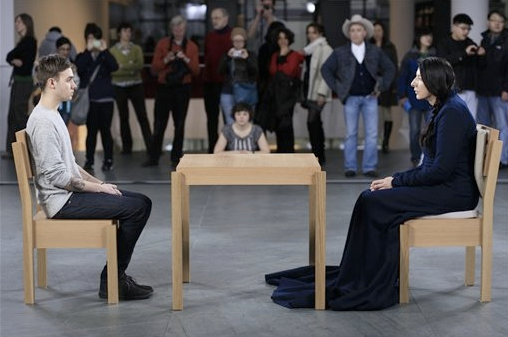MIT List Visual Arts CenterReview byShane GodfreyOver the past three years at art school I have been to all types of shows. Photography, painting, installation video, sculpture; name it and I have probably been to a gallery showing it. Walking into the List for this massive show of David Claerbout (a time based media artist) I knew almost nothing about the exhibition. The giant semi-transparent screen instantly captivated me as soon as I entered the first room. The big mesh screen showed the first piece, but we could also look ahead into what was coming next, which made my anticipation grow. I stood at the first screen looking at an image (
Shadow Piece, 2005) of a glass door and sidewalk for about four or five minutes and nothing was happening. I thought maybe it was a still image, but if it is a still image then why have the giant movie screen? I stayed around for a few more minutes and finally the shadows came rolling across the top of the first image. More life was brought into the image as people started to walk by; someone walked up to the door and tried to open it, but it was locked. For the viewer, it became a spectacle to watch the person respond by looking inside the door, trying to open it again, and then eventually giving up and moving on down the road with the rest of the passerbys.
 Shadow Piece, 2005
Shadow Piece, 2005Being able to see in the next room my anticipation for the next piece grew, so I moved on into the room to view three movies, including the first one seen when I walked through the door. In the center is a piece called
The Stack, 2002. It is a 36 minute film with the sun moving across an underpass of a junction of highways. Over the course of the movie the sun moves and a homeless man sleeping under the overpass is illuminated. And on the left is a thirteen hour movie called
Bordeaux Piece, 2001, which was shot over the course of a single day with the same actors, camera angles and dialogue. This is one of the more interesting pieces because the gallery is never open long enough to watch the whole movie even if someone would want to sit there for thirteen hours. The idea of the movie, and not necessarily the experience of viewing the movie, is why the piece so interesting. Sitting and looking at the left movie screen, you can see through to another room beyond that has two trees in an otherwise still image that are moving back and forth. Looking through the one movie to the other is visually compelling because the trees mirror each other and create a great layering and foreshadowing effect.
 Bordeaux Piece, 2001
Bordeaux Piece, 2001The visual experience of the films themselves may not be what is great, but the ideas that drive them are what make them stay with the viewer. The idea of shooting a movie for thirteen hours, acknowledging that no one will ever see the entire movie, and then having me (the viewer) also recognize they will never see the entire movie is an extremely interesting connection that I had with the show. Knowing that the video is always going to be the same each time, except with subtle lighting differences from one showing to the next, make the work seem impossible to absorb all at once--or ever. I have that feeling about almost all the work that is in the show. There is such a concern with time and scale and length that being able to absorb everything is difficult, but makes it more intriguing to think about after experiencing the videos.
 The Stack, 2002
The Stack, 2002The amount of work shown as well as the scale of the installation makes it worth going to visit the exhibition. In the time I was there, I probably roamed around watching each of the videos at least three times and wound up being there for about an hour. I wanted to stay longer and see how each video progresses and changes over time. Actually wanting to stay and look longer is something I have yet to experience in a gallery setting. Also being in a gallery for more than ten minutes is extremely rare for me and in general for most viewers. I feel like the show begs to make you stay and in the process makes you completely lose track of time, it was a fantastic experience that I would love to go back and take part in again.
Shane Godfrey is a BFA candidate at the Art Institute of Boston at Lesley University. His work is a hybrid of personal narratives, constructed photographs such as his Film Stills, 2006 and more recently photographs of daily encounters. For more information on his work visit www.shanegodfrey.com






























